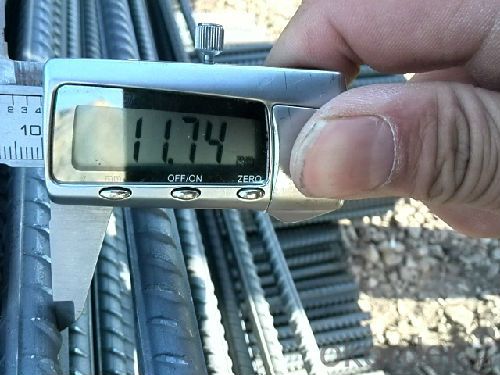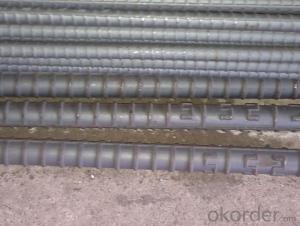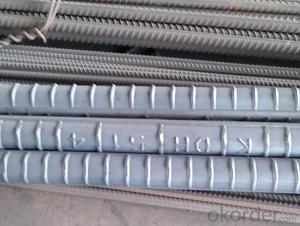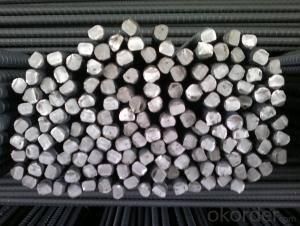Deformed steel bars type,Class IV Deformed Steel Bar with hige quality
- Loading Port:
- Tianjin
- Payment Terms:
- TT or LC
- Min Order Qty:
- 50 m.t.
- Supply Capability:
- 20000 m.t./month
OKorder Service Pledge
OKorder Financial Service
You Might Also Like
Product Description:
OKorder is offering Deformed steel bars type,Class IV Deformed Steel Bar with hige quality Building Material China Manufacturer at great prices with worldwide shipping. Our supplier is a world-class manufacturer of steel, with our products utilized the world over. OKorder annually supplies products to European, North American and Asian markets. We provide quotations within 24 hours of receiving an inquiry and guarantee competitive prices.
Product Applications:
Deformed steel bars type,Class IV Deformed Steel Bar with hige quality,Building Material China Manufacturer are ideal for structural applications and are widely used in the construction of buildings and bridges, and the manufacturing, petrochemical, and transportation industries.
Product Advantages:
OKorder's Deformed steel bars type,Class IV Deformed Steel Bar with hige quality,Building Material China Manufacturer are durable, strong, and resist corrosion.
Main Product Features:
· Premium quality
· Mill test certification
· Professional Service
· Competitive pricing
Product Specifications:
Product Name | Mark | Specification mm | Executive Standard | |||
Class IV Deformed Steel Bar | HRB400 | 6-32 | GB 1499.2-2007 | |||
Class V Deformed Steel Bar | HRB500 | 6-32 | GB 1499.2-2007 | |||
British Standard Thread | 460B B500B | 14-32 | BS4449:2005 | |||
Seismic Resistance Deformed Steel Bar | HRB400E HRB500E | 14-32 | GB 1499.2-2007 | |||
Anchor Bolt Steel | MG335 MG400 MG500 MG600 | 16-25 | Hot rolled ribbed bar for anchor bolt(exposure draft) | |||
MG335Y MG400Y MG500Y MG600Y | ||||||
FAQ
Q1: How do we guarantee the quality of our products?
A1: We have established an advanced quality management system which conducts strict quality tests at every step, from raw materials to the final product. At the same time, we provide extensive follow-up service assurances as required.
Q2: How soon can we receive the product after purchase?
A2: Within three days of placing an order, we will begin production. The specific shipping date is dependent upon international and government factors, but is typically 7 to 10 workdays.
Q3: What makes stainless steel stainless?
A3: Stainless steel must contain at least 10.5 % chromium. It is this element that reacts with the oxygen in the air to form a complex chrome-oxide surface layer that is invisible but strong enough to prevent further oxygen from "staining" (rusting) the surface. Higher levels of chromium and the addition of other alloying elements such as nickel and molybdenum enhance this surface layer and improve the corrosion resistance of the stainless material.
Images:


- Q:What are the advantages of using ribbed steel rebars?
- Using ribbed steel rebars in construction projects offers several advantages. To begin with, the ribbed design of these rebars enhances the bonding with concrete. The presence of ribs increases the contact surface area between the rebar and the surrounding concrete, resulting in improved adhesion and prevention of slippage. This ultimately leads to a stronger bond, ensuring the structural integrity of the reinforced concrete. Secondly, ribbed steel rebars provide enhanced resistance against shear forces. The ribs act as anchor points within the concrete, evenly distributing the load and reducing the risk of failure due to shear stress. This makes ribbed rebars particularly suitable for applications that experience high shear forces, such as beams and columns. Additionally, the ribbed pattern of these rebars improves their ductility. Ductility refers to a material's ability to undergo deformation without breaking. The presence of ribs allows the steel rebar to stretch and bend without fracturing, making it more resistant to cracking or failure under stress. This is particularly crucial in earthquake-prone areas, where a structure's ability to absorb and dissipate energy is vital for its survival. Furthermore, ribbed steel rebars demonstrate excellent corrosion resistance. The ribs act as a barrier, effectively preventing moisture and corrosive agents from reaching the steel core. This significantly prolongs the lifespan of the rebar, reducing maintenance costs and ensuring the long-term durability of the reinforced concrete structure. Lastly, ribbed steel rebars are readily available and cost-effective. They come in various sizes and lengths, allowing for easy customization to meet different construction needs. Additionally, due to their popularity and widespread use, ribbed rebars are competitively priced, making them a cost-effective option for reinforcing concrete structures. In conclusion, the use of ribbed steel rebars offers multiple benefits, including enhanced bonding with concrete, improved resistance to shear forces, greater ductility, excellent corrosion resistance, and cost-effectiveness. These advantages make ribbed rebars an ideal choice for reinforcing concrete structures, guaranteeing strength, durability, and longevity in construction projects.
- Q:Are there any specific guidelines for handling and storing steel rebars?
- Yes, there are specific guidelines for handling and storing steel rebars to ensure their quality and safety. Some of the key guidelines include: 1. Proper handling: Steel rebars should be handled with care to avoid any damage or bending. They should be lifted using appropriate equipment and not dragged or thrown. 2. Storage conditions: Rebars should be stored in a clean, dry, and well-ventilated area to prevent rusting and corrosion. They should be kept off the ground and away from moisture, chemicals, and direct sunlight. 3. Stacking: Rebars should be stacked in a way that ensures stability and prevents any deformation. They should be placed on flat surfaces and stacked in layers with wooden or rubber separators to avoid direct contact between rebars. 4. Labelling: Each bundle of rebars should be properly labeled with relevant information such as size, grade, and quantity for easy identification and inventory management. 5. Inspection: Regular inspections should be conducted to check for any signs of damage, rust, or corrosion. Damaged or corroded rebars should be discarded or repaired before use. Adhering to these guidelines is crucial to maintain the quality and integrity of steel rebars, ensuring their suitability for construction purposes.
- Q:What are the different types of steel rebars used in airport construction?
- There are generally two types of steel rebars commonly used in airport construction: epoxy-coated rebars and stainless steel rebars. Epoxy-coated rebars are corrosion-resistant and provide protection against chemicals often found in airports, such as de-icing agents. Stainless steel rebars, on the other hand, offer superior resistance to corrosion and are often used in areas with high humidity or exposure to saltwater. Both types of rebars are essential in ensuring the structural integrity and longevity of airport infrastructure.
- Q:What are the marking of the steel bars on the mills? Which factory is the 2LG16 thread?
- Each steel bar has an identification, each steel bar has a nameplate, each batch of steel bars have factory qualification certificate, and the qualification certificate is corresponding to the nameplate and the corresponding content of the identification, and has traceability.
- Q:How do steel rebars affect the overall thermal expansion of concrete structures?
- Steel rebars can significantly affect the overall thermal expansion of concrete structures. Concrete has a relatively low coefficient of thermal expansion, meaning it expands and contracts less compared to other materials when subjected to temperature changes. On the other hand, steel rebars have a higher coefficient of thermal expansion than concrete. When temperature fluctuations occur, such as during hot or cold weather, the steel rebars expand or contract at a different rate than the surrounding concrete. This difference in thermal expansion rates can lead to internal stresses within the concrete structure. These internal stresses can cause cracking or even structural failures if not properly addressed. To mitigate the effects of thermal expansion, engineers design concrete structures with appropriate reinforcement, including steel rebars. The rebars help to distribute the stresses caused by temperature changes more evenly, reducing the risk of cracking or damage. Additionally, the tensile strength of steel rebars allows them to resist the forces generated by the differential expansion, providing stability to the overall structure. However, it is important to note that steel rebars alone cannot completely eliminate the effects of thermal expansion. Other factors, such as the design of expansion joints and the use of proper construction techniques, also play a crucial role in minimizing the impact of temperature fluctuations on concrete structures.
- Q:How do steel rebars affect the overall cost of maintenance?
- Steel rebars can significantly impact the overall cost of maintenance. By utilizing high-quality steel rebars in construction projects, the durability and strength of structures are enhanced, leading to reduced maintenance needs in the long run. The use of corrosion-resistant rebars can also prevent deterioration caused by environmental factors, lowering maintenance expenses. Conversely, using low-quality or substandard rebars may result in structural issues and increased maintenance costs over time.
- Q:Can steel rebars be used in precast concrete?
- Yes, steel rebars can be used in precast concrete. Precast concrete is a construction method where concrete elements are manufactured off-site and then transported to the construction site for installation. Steel rebars are commonly used in precast concrete elements to provide reinforcement and increase the strength and durability of the concrete structure. The rebars are typically placed inside the precast concrete elements during the manufacturing process, ensuring that the concrete and steel work together to resist tensile forces and prevent cracking or failure. This combination of steel rebars and precast concrete allows for the creation of strong, reliable, and efficient construction elements that can be easily assembled on-site.
- Q:Can steel rebars be used in tunnel boring machine (TBM) construction?
- Yes, steel rebars can be used in tunnel boring machine (TBM) construction. Rebars are commonly used in the construction industry to reinforce concrete structures, including tunnels constructed using TBMs. The purpose of using rebars is to provide additional strength and durability to the concrete lining of the tunnel. These rebars are typically placed within the concrete lining during the construction process to enhance its structural integrity and ability to withstand external forces. In TBM construction, the rebars are carefully positioned and secured to ensure proper reinforcement throughout the tunnel. Therefore, steel rebars play a crucial role in the construction of tunnels using TBMs.
- Q:What is the role of steel rebars in preventing cracks in concrete?
- The role of steel rebars in preventing cracks in concrete is to provide reinforcement and strength to the structure. As concrete is strong in compression but weak in tension, the addition of steel rebars helps to distribute the tensile forces and resist cracking. The rebars act as a framework within the concrete, absorbing and dispersing the tension caused by external forces, such as loads or temperature changes. This reinforcement helps to increase the overall durability and structural integrity of the concrete, reducing the likelihood of cracks forming and ensuring the longevity of the construction.
- Q:How are steel rebars stored to prevent damage?
- Steel rebars are typically stored in an organized manner, either horizontally or vertically, to prevent damage. They are often placed on pallets or racks, ensuring they are off the ground to avoid contact with moisture. Additionally, rebars are often covered with tarps or protective materials to shield them from exposure to weather elements and potential rusting. Regular inspections are conducted to ensure rebars are not bent, twisted, or damaged, and any defective pieces are removed to maintain their structural integrity.
1. Manufacturer Overview |
|
|---|---|
| Location | |
| Year Established | |
| Annual Output Value | |
| Main Markets | |
| Company Certifications | |
2. Manufacturer Certificates |
|
|---|---|
| a) Certification Name | |
| Range | |
| Reference | |
| Validity Period | |
3. Manufacturer Capability |
|
|---|---|
| a)Trade Capacity | |
| Nearest Port | |
| Export Percentage | |
| No.of Employees in Trade Department | |
| Language Spoken: | |
| b)Factory Information | |
| Factory Size: | |
| No. of Production Lines | |
| Contract Manufacturing | |
| Product Price Range | |
Send your message to us
Deformed steel bars type,Class IV Deformed Steel Bar with hige quality
- Loading Port:
- Tianjin
- Payment Terms:
- TT or LC
- Min Order Qty:
- 50 m.t.
- Supply Capability:
- 20000 m.t./month
OKorder Service Pledge
OKorder Financial Service
Similar products
New products
Hot products
Related keywords





























